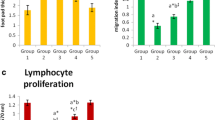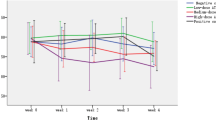Abstract
The immunosuppressive potential of aflatoxin B1 (AFB1), the carcinogenic metabolite ofAspergillus flavus, was evaluated in growing rats. The weanling rats were subchronically exposed to 60, 300 and 600 µg AFB1/kg body weight for four weeks on alternate days by oral feeding. Various parameters of cell mediated immunity (CMI) and humoral immunity were assessed in control and treated animals. CMI was evaluated by measuring delayed type of hypersensitivity (DTH) response and humoral by plaque forming cell (PFC) assay. The lymphoproliferative response assay for T- and B-cells was also performed. It was observed that AFB1 selectively suppressed cell mediated immunity in growing rats. AFB1 suppressed CMI at the 300 and 600 µg dose levels only as measured by DTH response assay. It is concluded that continuous low level exposure of aflatoxin to growing host may enhance its susceptibility to infection and tumorigenesis.
Similar content being viewed by others
Abbreviations
- AF:
-
Aflatoxin
- AFB1 :
-
Aflatoxin B1
- CMI:
-
Cell mediated immunity
- CPM:
-
Counts per minute
- DTH:
-
Delayed type of hypersensitivity
- GST:
-
Glutathione-S-transferase
- LPS:
-
Lipopolysaccharide
- PFC:
-
Plaque forming cell
- PHA:
-
Phytohemagglutinin
- SRBC:
-
Sheep red blood cells
References
Raisuddin, Singh KP, Zaidi SIA, Saxena AK, Ray PK. Effects of aflatoxin on lymphoid cells of weanling rat. J Appl Toxicol 1990; 10: 245–50.
Denning DW, Allen R, Wilkinson AP, Morgan MRA. Transplacental transfer of aflatoxin in humans. Carcinogenesis 1990; 11: 1033–5.
Wild CP, Rasheed FN, Jawla MFB, Hall AJ, Jansen LAM, Montesano R. In-utero exposure to aflatoxin in West Africa. Lancet 1991; 337: 1602.
De Vries HR, Maxwell SM, Hendrickse RG. Fetal and neonatal exposure to aflatoxins. Acta Paediatr Scand 1989; 78: 373–8.
Coulter JBS, Lamplugh SM, Sulimen GI, Omer MIA, Hendrickse RG. Aflatoxins in human breast milk. Ann Trop Paed 1984; 4: 61–6.
Wild CP, Pionneau F, Montesano R, Mutiro CF, Chetsanga CJ. Aflatoxin detected in human breast milk by immunoassay. Int J Cancer 1987; 40: 328–33.
VanEgmond HP, Paulsch WE. Mycotoxins in milk and milk products. Neth Milk Dairy J 1986; 40: 175–88.
Raisuddin S, Zaidi SIA, Singh KP, Ray PK. Effect of subchronic aflatoxin exposure on growth and progression of Ehrlich's ascites tumor in mice. Drug Chem Toxicol 1991; 14: 185–206.
Ray PK, Singh KP, Raisuddin, Prasad AK. Immunological responses to aflatoxins and other chemical carcinogens. J Toxicol Toxin Rev 1991; 10: 63–85.
Luster MI, Dean JH, Moore JA. Evaluation of immune functions in toxicology. In: Hayes AW, ed. Principles and methods of toxicology. New York: Raven Press, 1982: 561–86.
Kannan K, Singh KP, Goel SK, Shanker R. Effect of 2,5 hexanediol on immunocompetence of mice. Environ Res 1985; 36: 14–25.
Zaidi SIA, Singh KP, Raisuddin, Saxena AK, Ray PK. Protein A induced abrogation of cyclophosphamide toxicity is associated with concomitant potentiation of immune function of host. Immunopharmacol Immunotoxicol 1990; 12: 479–512.
Urbaniak SJ, White AG, Barclay GR, Wood SM, Kay AB. Tests of immune function. In: Weir DM, ed. Handbook of experimental immunology, Vol. 3. Oxford: Blackwell Scientific Publications, 1978: 47.1–47.31.
Reddy RV, Taylor MJ, Sharma RP. Studies of immune function of CD-1 mice exposed to aflatoxin B1. Toxicology 1987; 43: 123–2.
Reddy RV, Sharma RP. Effects of aflatoxin B1 on murine lymphocytic functions. Toxicology 1989; 54: 31–44.
Alexander P, Fairley GM. Cellular resistance to tumors. Br Med Bull 1967; 23: 86–92.
Wasserman M, Wasserman D, Kedar E, Dajavherian M. Immunological and detoxification interactions in p,p-DDT fed rabbits. Bull Environ Contam Toxicol 1971; 6: 426–35.
Autrup H, Harris CC, Stoner GD, Silkirk JK, Schafer PW, Trump BF. Metabolism of [3H]-benzo[a]pyrene by cultured human bronchus and human pulmonary alveolar macrophages. Lab Invest 1978; 38: 217–24.
Yang KH, Kim BS, Munson AE, Holsapple MP. Immunosuppression induced by chemicals requiring metabolic activation in mixed cultures of rat hepatocytes and murine splenocytes. Toxicol Appl Pharmacol 1986; 83: 420–9.
Kaminiski NE, Barnes DW, Jordan SD, Hollsapple MP. The role of metabolism in carbon tetrachloride-mediated immunosuppression: In vivo studies. Toxicol Appl Pharmacol 1990; 102: 9–20.
Raisuddin S, Parmar D, Zaidi SIA, Singh KP, Verma AS, Seth PK, Ray PK. Effects of subchronic aflatoxin exposure on the activities of some hepatic drug metabolising enzymes in weanling rats. Toxicol Lett 1992 (communicated).
Robertson IGC, Birnbaum LS. Age related changes in mutagen activation by rat tissues. Chem Biol Interact 1982; 38: 243–52.
Gregas Z, Varga F, Schmelas A. Age-development and inducibility of hepatic glutathione-S-transferase activities in mice, rats, rabbits and guinea pigs. Comp Biochem Physiol 1985; 80C: 85–90.
Degan GH, Neumann GH. The major metabolite of aflatoxin B1 in rat is a glutathione conjugate. Chem Biol Interac 1978; 22: 239–55.
Neal GE, Green JA. The requirement for glutathione-S-transferase in the conjugation of activated aflatoxin B1 during aflatoxin hepatocarcinogenesis in the rat. Chem Biol Interact 1983; 45: 259–75.
Quinn BA, Crane TL, Kocal TE, Best SJ, Cameron RG, Rushmore TH, Farber E, Hayes MA. Protective activity of different hepatic cytosolic glutathione-S-transferases against DNA-binding metabolites of aflatoxin B1. Toxicol Appl Pharmacol 1990; 105: 351–63.
Allameh A, Saxena M, Raj HG. Interaction of aflatoxin B1 metabolites with cellular macromolecules in neonatal rats receiving carcinogen through mother's milk. Carcinogenesis 1989; 10: 2131–4.
Author information
Authors and Affiliations
Rights and permissions
About this article
Cite this article
Raisuddin, S., Singh, K.P., Zaidi, S.I.A. et al. Immunosuppressive effects of aflatoxin in growing rats. Mycopathologia 124, 189–194 (1993). https://doi.org/10.1007/BF01103737
Received:
Accepted:
Issue Date:
DOI: https://doi.org/10.1007/BF01103737




